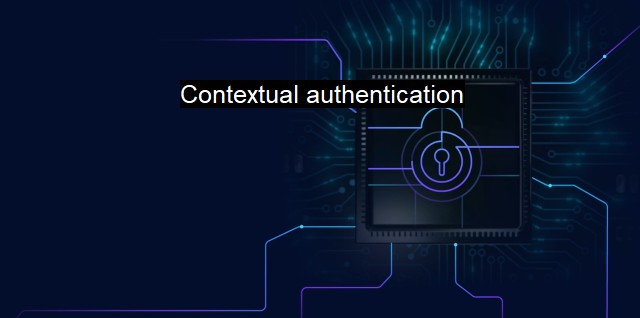What is Contextual authentication?
Contextual Authentication: The Future of Cybersecurity in the Era of Digitalization
Contextual authentication is an evolving form of cybersecurity practice that authenticates users based on numerous factors, all derived from the context of the transaction or access request made by the user. Simply put, these are various aspects associated with the user's behavior that an authentication mechanism uses to make real-time decisions about the legitimacy of the activity. The term 'context' here pertains to the information utilized by the authenticating mechanism to assess if the user’s identity is genuine.Traditionally, cybersecurity strategies primarily involved using pre-set static passwords for gaining access to secure data spaces. But over time, due to the expanding complexity of the digital world and ever-increasing cyber threats, static passwords insufficiently provided the necessary protection. Contextual authentication emerged as an optimal solution with its dynamic and risk-based approach to cybersecurity.
Rather than relying on traditional knowledge-based forms of authentication (like passwords and personal identification numbers), contextual authentication takes into consideration various factors about the user's environment. These factors usually encompass data about the user's location, device information, network security, time of login and user behavior such as typing patterns, commonly accessed locations, and request histories.
For instance, if a user typically logs in from a specific city using a particular device and all of a sudden, they are trying to log in from a completely different location and on a different device, this sudden change in behavior could be flagged. This out-of-place login request may prompt extra security measures through the contextual authentication system, such as requesting additional proof of identification before allowing access.
The cornerstone for contextual authentication is machine learning and Artificial Intelligence. AI analyses and 'learns' the usual habits based on the contextual information of the user. Anomalies, in case of any, can be flagged, and authentication would be denied or a second factor of authentication would be prompted depending upon the calculated risk.
Contextual authentication offers a proactive approach to information security. An advanced system considers users' historical behaviors and compares them with each incoming transaction to make risk assessments, thus preventing suspicious anomalies before causing harm.
While the key benefit of contextual authentication is increased security, it also contributes to an improved user experience. By unobtrusively monitoring factors such as behavior and location, it aids smooth logins without adding extra steps for the user while maintaining the security integrity. It allows users to get on with their tasks with minimum friction while ensuring there is an adequate level of security overseeing every operation.
Like any other security mechanism, it does have its challenges. Implementing contextual authentication would involve carefully assimilating and processing large amounts of data in real-time. With any technology that relies on data, its effectiveness directly correlates to the quality and relevance of the collected information. Also, there are privacy concerns that need to be addressed; companies need to ensure refined data handling practices, inform their customers about data collection processes, and handle this communication transparently.
Contextual authentication can significantly boost the effectiveness of cybersecurity and antivirus defense. By complementing traditional password systems, and by providing early detection and proactive incident response, it offers a valuable tool to help protect both businesses and their end-users. It is critical to conduct careful planning and attend to privacy concerns while doing so. Entities implementing this technology should strive for a delicate balance - harnessing the potential of contextual authentication without compromising their users' trust and comfort.

Contextual authentication FAQs
What is contextual authentication?
Contextual authentication is a cybersecurity technique that verifies a user's identity based on various contextual factors, such as their location, device, network, behavior, and other relevant metadata.How does contextual authentication help in antivirus protection?
Contextual authentication can help antivirus protection by providing an additional layer of security and reducing false positives. By analyzing the context of a user's login attempt or transaction, it can distinguish between legitimate and suspicious activities and challenge risky ones with additional authentication measures. This can help prevent malware from infiltrating the system or stealing sensitive data.What are some examples of contextual authentication techniques?
Some examples of contextual authentication techniques include geolocation tracking, IP reputation analysis, device fingerprinting, biometric authentication, behavior analysis, and risk-based scoring. These techniques can be used individually or in combination to create a contextual profile of the user and assess their credibility and trustworthiness.What are the benefits of contextual authentication over traditional authentication methods?
The benefits of contextual authentication over traditional authentication methods include improved security, convenience, and user experience. Contextual authentication can adapt to the evolving threat landscape and provide a dynamic and personalized security approach that reduces the reliance on static factors such as passwords. It can also simplify the authentication process for users by eliminating the need for multiple credentials and reducing the risk of credential stuffing or phishing attacks.| | A | | | B | | | C | | | D | | | E | | | F | | | G | | | H | | | I | | | J | | | K | | | L | | | M | |
| | N | | | O | | | P | | | Q | | | R | | | S | | | T | | | U | | | V | | | W | | | X | | | Y | | | Z | |
| | 1 | | | 2 | | | 3 | | | 4 | | | 7 | | | 8 | | |||||||